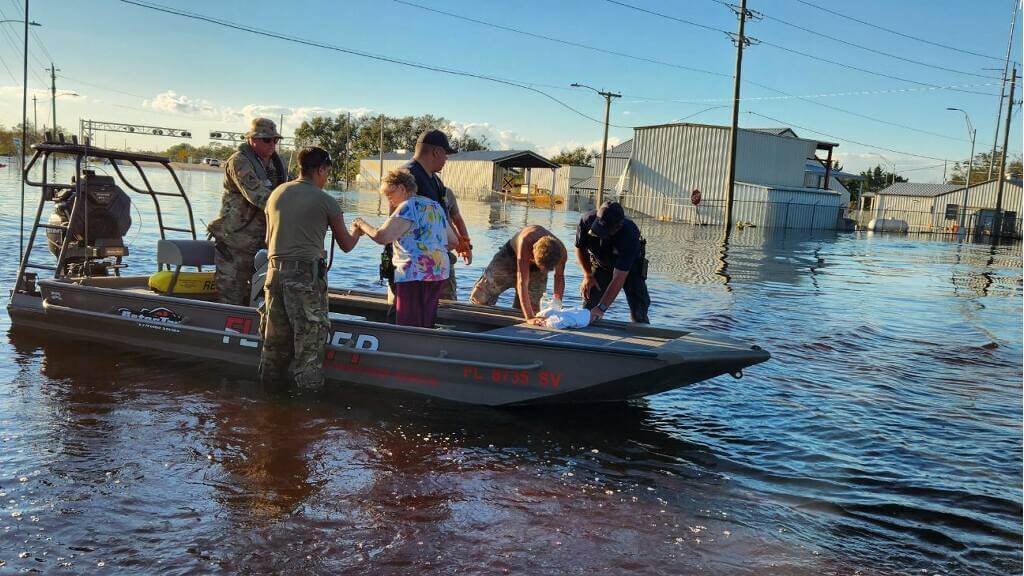Natural disasters can happen anytime and have huge impacts on the communities they affect. Many states prepare for these sudden disasters by mobilizing National Guard units at least annually.
Here are some examples of how different National Guard units have prepared for natural disasters:
Florida National Guard
The Florida National Guard is often called upon to respond to hurricanes and their aftermath. In 2022, more than 5,000 National Guard soldiers and airmen responded to Hurricane Ian.
Lt. Col. Blake Heidelberg, director of military support for the Florida National Guard, said the Guard was in its annual hurricane and domestic operations exercise earlier in May. This exercise focused on ensuring units knew how to respond and what to expect in a major hurricane. The Guard used Hurricane Ian as an example in this exercise.
“We mostly did some search and rescue early on. A lot of debris removal because there was a very rural area with a lot of trees and a lot of support to the local entities trying to get into different areas with that debris removal. And then, we did a lot of points of distribution in those rural communities. So that was our last response. But you’re only as good as your last response. So that’s why we’re in the exercise now, preparing for the future and preparing for that,” Heidelberg said.
The National Oceanic and Atmospheric Administration’s National Weather Service forecasters predicted above-normal activity for the 2024 Atlantic hurricane season, with approximately eight to 13 storms becoming hurricanes. Hurricane season runs from now to Nov. 30.
Alaska National Guard
Col. Matthew Kirby, commander of the 176th Mission Support Group, says they have to constantly be prepared because natural events occur quite frequently in Alaska due to the “Alaska Factor.”
“Everything is more challenging in Alaska. It seems like the natural disasters are bigger, the fires are bigger, the floods are bigger, and the icebergs are ginormous. They’re the size of houses. And we just call it the Alaska Factor because you got to take that into consideration whenever we’re responding,” Kirby said. “Due to the size, scope, and scale of the state itself and the lack of infrastructure to move around, we need to take that into consideration because the time-distance problem is a very real problem for us.”
The Alaskan National Guard conducts one training session every year to assess how they would respond to Alaska’s worst day — the 1964 Good Friday Earthquake. That earthquake, which occurred on March 27, 1964, resulted in 131 deaths and is known as the third-largest earthquake ever recorded in human history and the largest earthquake in North America.
“What I would say that does for us is that allows us to respond to all the random things that happened in Alaska during a year, that much better,” Kirby said, “Because if we can respond on the worst day to that worst event, then the things that happen day to day in Alaska — like landslides into the ocean, smaller earthquakes, flooding, fires, all these things — we’re prepared to respond to because we’ve been training so much every year for that big event.”
Tennessee National Guard
The Tennessee National Guard annual training is in response to flooding natural disasters. Capt. Autumn Hester said the last primary response for the Tennessee National Guard was the flooding in Waverly in 2021 in which at least 20 people were killed.
Hester said this year’s training event will focus on their helicopter aquatic rescue teams.
“We’re doing an air refill mission that is joint with the Tennessee Air National Guard. They will be refueling, in the air, a KC-135 to a C-17. Once the C-17 lands, it will de-fuel into a HEMTT, and then that HEMTT is going to refuel a UH-60,” Hester said.
Looking ahead to next year’s training exercise, Hester says they will focus on responding to earthquakes. Tennessee is in the New Madrid Seismic Zone, so the National Guard will simulate what it would be like if a major earthquake occurred in their state. In 2023, Tennessee had 296 measurable quakes.

